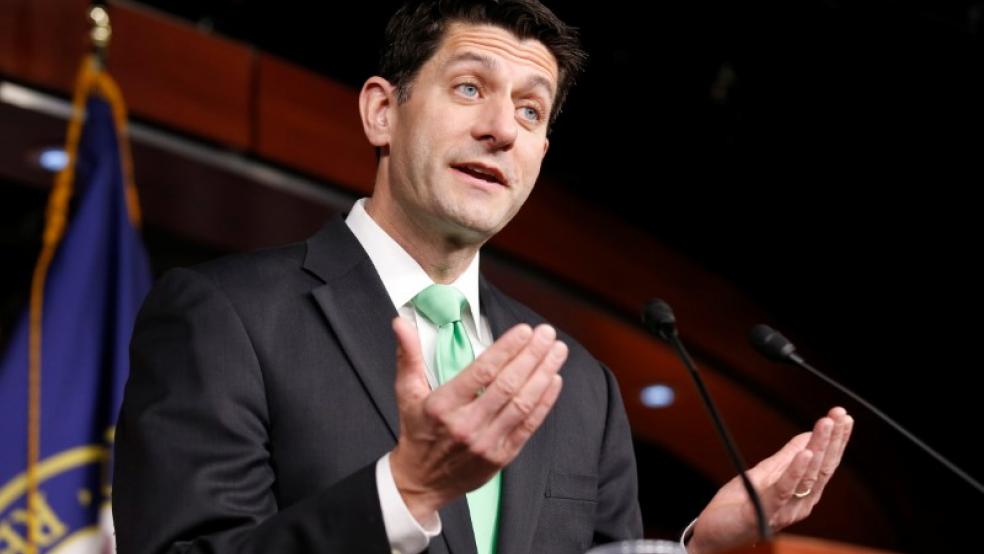House Speaker Paul Ryan is making what might be the biggest gamble of his career to date, forging ahead with a fiscal year 2017 budget even though fiscal conservatives say they will oppose it.
Ryan’s blueprint, which the House Budget Committee could begin marking up as soon as Wednesday, sticks to the $1.07 trillion agreed upon spending level in the two-year budget deal struck by the White House and congressional leaders. He’s ignoring demands from the far-right House Freedom Caucus to shave $30 billion off the topline.
Related: Why the GOP’s Budget Plans Are Going Off the Rails
While budgets do not fall under the rule of law, they do act as a fiscal roadmap, detailing the majority’s spending priorities. Ryan, who wants the House Republican Conference to offer a conservative vision for voters in a presidential year, has said crafting a budget would be a critical part of making the GOP case. However, he didn’t outright demand one.
Last month told his members they could adhere to the budget deal, lower the agreement’s caps – a move that would have enraged moderates – or simply skip a budget all together, a political embarrassment that would have increased the chances of a catch-all omnibus appropriations bill to fund the government.
The last scenario has favored Democrats in recent years because Republicans have been unable to cobble together the necessary 218 votes to pass the legislation, giving the minority a big say in how the dollars are spent.
Ryan and House Budget Chair Tom Price (R-GA) previously floated budget proposals to the 40-odd Freedom Caucus members at least twice. The plans were rejected. By moving forward with a budget now, Ryan is hoping enough Republicans stay on the reservation to get it approved and not test his previous claims that he’s okay with introducing legislation that dies on the House floor.
Related: Paul Ryan’s Three Perilous Paths to a Budget Deal
Speaking to reporters on Tuesday, Ryan insisted he would remain neutral.
"I promise in this speakership that we're not going to have a top-down, cram-it-down-people's-throat kind of leadership," he said. "We're going to make decisions as a team. We're going to push power out to the members, and we're going to make a team decision on this issue.”
While trying to stay above it all may work for now, conservative anger could begin to fester in the days and weeks ahead and begin to mirror the atmosphere of Ryan’s predecessor, John Boehner, who the Freedom Caucus drove from office last year.
Ryan’s plan aims to balance the budget within a decade and relies on what has become standard GOP cost-cutting measures, like repealing Obamacare and defunding the Environmental Protection Agency. It also creates a pay-in structure for Medicare and gives states control over the food stamps program.
Related: Why Paul Ryan's Budget Deal Could Go Down in Flames
The proposal also adds $89 billion in military funding, including roughly $17 billion plus for the Overseas Contingency Operations (OCO) account, commonly known as the war fund. The boost is clearly aimed at House defense hawks who have argued OCO needed to be increased by more than $20 billion.
In a sign of how tough the road ahead is for Ryan, a leading conservative think-tank panned the budget proposal. “This budget is not a serious effort to tackle our mounting debt caused by wasteful spending,” Paul Winfree, director of the Thomas A. Roe Institute for Economic Policy Studies at the Heritage Foundation, said in a statement. “Once again Congress promises future spending cuts in return for higher spending today. That’s no longer acceptable. The future cuts never come.”
"Congress should act now. They should move forward boldly and enact long-promised spending reforms that will reduce the deficit and lead us to a balanced budget and economic growth,” he added.
The DC-based organization recently unveiled its own take on the budget, which slashed discretionary spending by $80 billion by reducing funding for things like Head Start, the federal pre-K program for low-income children, and outright zeroing out money for Amtrak.
Predictably, House Minority Leader Nancy Pelosi (D-CA) blasted the GOP blueprint.
“The Republican Congress has grown so cruelly dysfunctional that the Tea Party wing of the House GOP already opposes the budget as insufficiently radical – even with $6 trillion in cuts and ending the Medicare guarantee,” she said in a statement.“Once again, Republicans are trying to take us back to the radical trickle down agenda that shattered our economy and hollowed out the wages of middle-class Americans.”





